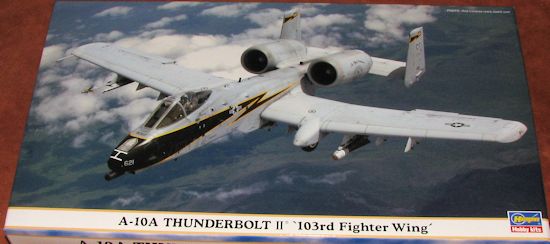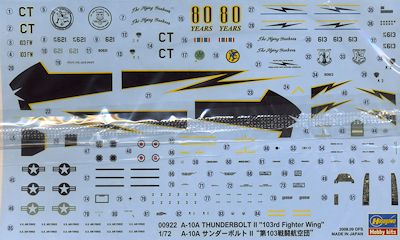
Hasegawa 1/72 A-10 Thunderbolt "103 FW"
| KIT #: | 00922 |
| PRICE: | $11.75 on sale ($38.99 SRP) |
| DECALS: | Two options |
| REVIEWER: | Scott Van Aken |
| NOTES: | 2008 Reissue |

| HISTORY |
The Fairchild Republic A-10 Thunderbolt II is an American single-seat, twin-engine, straight-wing jet aircraft developed by Fairchild-Republic in the early 1970s. The A-10 was designed for a United States Air Force (USAF) requirement to provide close air support (CAS) for ground forces by attacking tanks and other armored vehicles, and other ground targets with a limited air defense capability. It was the first USAF aircraft designed solely for CAS.
The A-10 was designed around the GAU-8 Avenger, a heavy rotary cannon that forms the aircraft's primary armament. (It is, to date, the heaviest rotary cannon ever mounted on an aircraft.) The aircraft's hull incorporates over 1,200 pounds (540 kg) of armor and was designed with survivability as a priority, with protective measures in place which enable the aircraft to continue flying even after taking significant damage.
The A-10's official name comes from the Republic P-47 Thunderbolt of World War II, a fighter that was particularly effective at close air support. The A-10 is more commonly known by its nickname "Warthog" or simply "Hog". As a secondary mission, it provides airborne forward air control, guiding other aircraft against ground targets. A-10s used primarily in this role are designated OA-10. The A-10 is not expected to be replaced until 2028 or later.
The A-10 has received many upgrades over the years. Aircraft added the Pave Penny laser receiver pod beginning in 1978. It senses reflected laser radiation from a laser designator on a target for faster and more accurate target identification. The A-10 began receiving an inertial navigation system in 1980. Later, the Low-Altitude Safety and Targeting Enhancement (LASTE) upgrade provided computerized weapon-aiming equipment, an autopilot, and a ground-collision warning system. The A-10 is now compatible with night vision goggles for low-light operation. In 1999, aircraft began to receive Global Positioning System navigation systems and a new multi-function display. Its LASTE system is being upgraded with the Integrated Flight & Fire Control Computers (IFFCC).
In 2005, the entire A-10 fleet also began receiving the Precision Engagement upgrades that include an improved fire control system (FCS), electronic countermeasures (ECM), and the ability to aim smart bombs. The aircraft that receive this upgrade are redesignated A-10C. The C model upgrades were to be completed in 2011. The Government Accounting Office in 2007 estimated the cost of upgrading, refurbishing, and service life extension plans for the A-10 force to total $2.25 billion through 2013.
Modifications to provide precision weapons capability are well underway. In July 2010, the USAF issued Raytheon a contract to integrate a Helmet Mounted Integrated Targeting (HMIT) system into A-10Cs. The Air Force Material Command's Ogden Air Logistics Center at Hill AFB, Utah completed work on its 100th A-10 precision engagement upgrade in January 2008.
The A-10 will receive a service life extension program (SLEP) upgrade with many receiving new wings. The service life of the re-winged aircraft is extended to 2040. A contract to build 242 new A-10 wing sets was awarded to Boeing in June 2007. Two A-10s flew in November 2011 with the new wing installed.
| THE KIT |
 Hasegawa
is the king of kit reissues, each one coming with basically different decals.
This one is no exception. The kit itself is not a bad one by any means, but is
of the very early A-10. As an example, there are not even any chaff dispensers
and the antenna suite is typical of the planes from the 1970s before the first
upgrade. The kit is of such an age that the panel lines are all raised.
Hasegawa
is the king of kit reissues, each one coming with basically different decals.
This one is no exception. The kit itself is not a bad one by any means, but is
of the very early A-10. As an example, there are not even any chaff dispensers
and the antenna suite is typical of the planes from the 1970s before the first
upgrade. The kit is of such an age that the panel lines are all raised.
You get a fairly nice seat for the once piece cockpit. The instruments on the main panel and side consoles are decals as is the norm for Hasegawa. The cockpit sits atop the nose gear well. The kit offers a vent that goes over the gun gas extraction ports if the aircraft you are modeling needs it. As the A-10 is a rather tail heavy model, you will need 18 grams of weight (which is a LOT). There is room for this in the small space in the nose and behind the cockpit. A smart modeler will tape on all the major airframe bits to ensure there is enough weight installed.
Engines are designed with the covers closed, which most folks will want. There are aftermarket sets for those who wish an exposed engine. The kit comes with a separate entry door so that can be posed with the ladder down. A separate windscreen and canopy are provided, both of which are quite clear. The canopy can be posed open.
The kit comes with eleven pylons and you also get some
weapons to install on them. For instance, you get two LGBs, two triple Maverick
racks with missiles, Two MERS with mk 82 slicks, two larger Mk. 82 bombs, a
travel pod and a pair of long range fuel tanks. I have to say that the mbombs
are pretty generic looking and would best be replaced. Though the box art shows
a Sidewinder rack, this is not included as that ability was not part of the
original aircraft, of which this kit represents.
You get a set of the original instructions for kit E9 with a small addendum sheet so you can apply the decals included. Both markings are for a grey 118 FS Connecticut ANG plane. One is the box art plane with special paint for it s 80th anniversary while the other set of markings are for a standard line bird from the same unit. As a note, the 118 FS transitioned to the C-21A in 2005. Those wishing to portray another unit can do so with all the aftermarket decals that have been done for this plane. I would like to think there is also an upgrade set for this kit to make a more modern A-10A or even the A-10C.
| CONCLUSIONS |
There have been more modern moldings of this aircraft and some of those are of the upgraded versions of the A-10. This does not mean this is a 'bad' kit, just that you need to be aware of its limitations. If you are building an early A-10 and can find this one on sale as did I, it is well worth picking up.
| REFERENCES |
http://en.wikipedia.org/wiki/A-10_Thunderbolt_II
March 2013
Thanks to me for picking this one up.
If you would like your product reviewed fairly and fairly quickly, please contact the editor or see other details in the Note to Contributors.